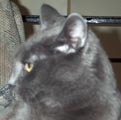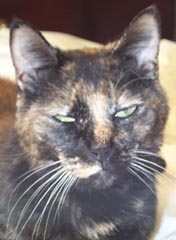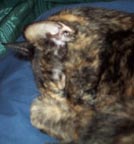
Ricki
|
April 2000,
What color was Ricki's father?
Part 2
|
|
Last month, I began looking at the genes that control the
coloration of cats in an effort to figure out what color the father
of my cat, Ricki, was. Ricki is a Tortoiseshell, and her mother,
Ashley, is all gray. Ricki must have had some color influence from
her father, but what?
|

Ashley
|
Previously, I discussed the black pigmentation gene, B, and its mutation b (for chocolate), and the dense pigmentation gene which controls how the pigment granules are packed in each hair (D = densely packed; d = dilute). Now, for the rest of the storyÖ
More Complex Gene Combinations
As mentioned, the A and T genes work together to produce the tabby. The Tabby (T) gene is responsible for four different types of tabby patterns: striped (or mackerel), spotted, blotched (classic), and Abyssinian. The Agouti (A) gene controls the color of the background. It can be grayish, yellowish gray, or reddish-yellow, and is composed of hairs that are banded with varying amounts and intensities of yellow. A has mutated to a (non-agouti). Non-agouti lacks the yellow band to the hairs, thereby producing a self-black cat. That is, the black pigment is distributed along the entire length of the hair in the background so the background is black, and the tabby pattern doesnít show up.
A cat with AATT is a striped tabby, and AA tbtb
is a blotched tabby; however, aaTT and aatbtb
are both black. What this means is that the mutated form, a, will
obscure the effects of the T gene, except there may be some residual,
ghost tabby pattern if the catís coat is seen in full light.
The Readerís Digest Illustrated Book of Cats makes this
additional point concerning tabby patterns in red (orange, cream, or
yellow) cats: "It is practically impossible to obtain a solid red
or cream coat, however. All red or cream cats have a tabby pattern
to a greater or lesser degree." Apparently, the aa combination
hides the tabby pattern for black colors only.
Here are some examples of cat colors with the aa gene combination. There is no tabby pattern in these combinations.
- aaBBDD Ė black
- aaBBdd Ė blue (as in the Russian Blue)
- aabbDD Ė Havana
- aabbdd Ė lilac
A tabby cat or an Abyssinian, however, has AA (or Aa) and some
form of the T gene. (The Abyssinianís gene is a mutation, Ta.)
A blotched (classic) tabby might be A-B-D-tbtb in which case
the cat is a tabby with black stripes or blotches. If the cat has
A-bbD-tbtb, it is a chocolate tabby.
Full Color
The full color gene, C, determines whether the cat has the color
in its full intensity, that is, whether the pigment color is at its
full strength. (This is not to be confused with D, which controls the
density of the pigment granules in a hair.) One mutation is cs,
which causes a Siamese coloration, or full intensity color only at
the points. Another mutation ca is a blue-eyed albino, while yet
another mutation, c, is a pink-eyed albino. (You may have heard that
some white cats are deaf, but not because of the c gene. Deafness
is linked instead to a different gene that causes whiteness, W.)
The Interesting Gene for Red Coloration
Perhaps the most interesting gene is the one for red
(orange/yellow/cream) pigmentation. The cat is rare in that its O
gene is sex-linked. The O gene (or its mutation, o) can only occur
on X-chromosomes. Therefore, only female cats can have two O genes.
Males will always have only one. (There is an exception to this. The
rare, and normally sterile, XXY male can have two O genes because it
has two X-chromosomes.)
For the O gene, a male cat can only have two combinations, OY
(where Y stands for the Y chromosome which doesnít have the O gene)
and oY. A female cat can have four combinations: OO, Oo, oO, and oo. If only the capital O form occurs, it makes the cat orange. Only little o means the orange pigment is absent, so the cat is black, brown, blue, or lilac (depending upon the states of the B and D genes). Because male cats can only have O or o, they are either red (or one of redís variations) or black (or one of blackís variations). A female with OO is red (or a variation), and one with oo is black (or a variation).

|
But females can have an O and an o. In this situation, O does not
completely dominate. Instead both red and black pigmentation occurs
Ė in other words, a Tortoiseshell. Ricki is what is called a red and
black Tortoiseshell. Therefore she has the following set of genes:
B-C-D-Oo
(B- means that the combination could be BB, Bb, or bB. C- means
CC, Cc, or cC, and D- means DD, Dd, or dD.)
|
Tortoiseshells come in other color combinations. For example, a
chocolate Tortoiseshell is bbC-D-Oo. A blue cream Tortoiseshell is
B-C-ddOo, where the density of pigmentation in the hairs is diluted.
I know what Rickiís mom-cat, Ashley, looks like, so I can guess at her genetic combination.
aaB-C-ddoo
Because Ashley has oo, she gave Ricki an o gene. But Ricki also
has an O gene, so the O must have come from her father. And because
males can only have one O gene, Rickiís father was an OY Ė a
red/orange cat (the O gene will override the effects of the B gene).
Also, Ricki has a D gene. Ashley has dd, so Rickiís father must have
passed on a D gene. Therefore, he was probably a full color red/orange rather
than a cream color.
Because the Readerís Digest Illustrated Book of Cats says that
most red (orange/yellow/cream) cats have at least a little tabby
patterning, Rickiís father probably had some markings. But Ricki has
both red and black colors. Does she have any tabby markings?
Interestingly, the tabby and agouti genes seem to act a little
differently with Tortoiseshells.
According to the Book of Cats, red and black tortoiseshells have
aa. The book also goes on to say, on page 145:
"Tabby markings may be present in red and cream areas,
especially on the extremities of the cat, but will not be present on
the body if the catís gene mixture contains the agouti tabby gene.
If the eumelanin [black] areas have any tabby patterning, the cat is
a torbie."
Ricki does not have any tabby patterning in the black areas, so she must have aa. (Rickiís father must have had at least one a gene.) But she does have both red and yellow/cream. The Standard Guide to Cat Breeds book says the following:
"The tortoiseshell (aaOo) is a brindled mosaic of
black, red, and cream. The variety does not posses three colors, of
course; the red is produced by the intense tabby pattern (usually
blotched) while the yellow [cream] is produced by the paler areas
between the pattern."
Consequently the cream color in Rickiís coat is not caused by dilution (d), but rather by a tabby pattern.
White, or the Absence of Color
The one aspect of color, white, is controlled by two genes. The W gene overrides all the other colors and produces an all white cat. A cat with these genes AATTWW is called a white carrying tabby. A cat with aaTTWW is called a white carrying black. But both of these cats look the same, namely all white. If a cat has ww, it is a normal colored cat, although the other white color gene may come into play.
The other gene that controls white is called the Spotting gene, S. A Tortoiseshell and White cat or a Calico cat has an S gene. S does not completely dominate, so Ss has less white than SS. The only white Iíve ever found on Ricki is between the pads of two of her paws, and even then it could be a very light cream, so I donít know if she has an S gene or not. Ashley has no white, so she is wwss. It is possible that Rickiís father was a wW cat (or all white), or an sS (bicolor, white and orange).
Educated Guess
Rickiís final gene determination: aaB-C-D-Oossww
Ashleyís: aaB-C-ddoossww
|
Rickiís father: aaB-C-D-OYssww, or A-B-C-D-OYS-ww, or aabbC-D-OYssww,
or A-bbC-D-OYS-ww, or A-bbC-D-OYS-W-, or A-B-C-D-OYssW-,
or A-B-C-D-OYS-W-, or A-bbC-D-OyssW-.
But in simple terms Ė Rickiís father was most likely an orange cat or an orange and white cat, or possibly a white cat carrying orange. The important gene (in my opinion) is the O. That combined with Ashleyís o resulted in Rickiís Tortoiseshell Oo.
|

Nap Time
Gene Symbols
|
A |
Agouti (tabby background) |
a |
Non-agouti |
|
B |
Black Pigment |
b |
Chocolate |
|
C |
Full color |
c, cs, etc. |
Varying degrees of less intense color |
|
D |
Full pigment density (in individual hairs) |
d |
Dilute density |
|
O |
Orange |
o |
Non-orange |
|
S |
White spotting |
s |
No white spotting |
|
T |
Tabby patterns |
t, ta, tb |
Different types of patterns |
|
W |
All white |
w |
Normal color |
Sources:
The Readerís Digest Illustrated Book of Cats, The Reader's Digest Association (Canada) Ltd.,
Montreal, 1992, pp. 142-151.
A Standard Guide to Cat Breeds, Richard H. Gebhardt, Grace Pond, and Dr. Ivor Raleigh, Eds.,
McGraw-Hill Book Company, New York, 1979, pp. 15-23.
I've done my best in interpreting how cat genes interact to create
the colors of a Tortoiseshell. If anyone finds any mistakes in what
I've written here, please
contact me.
|



